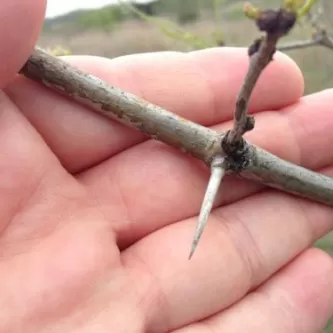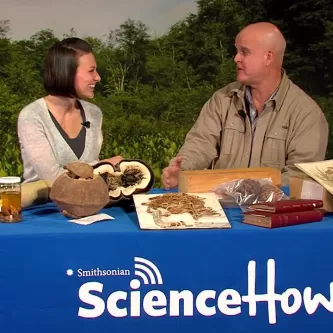Search
Collecting Natural History
Time Traveling with Natural History Objects
If you have ever wished to be a time traveler, get to know a set of natural history collections. On the surface, natural history collections are a bunch of bones, rocks, projectile points, or other found objects.
Dig a little deeper and you will find that each object can take you on a journey to another time and place. The objects tell many stories, depending on what you ask of them. They can offer information about conditions, events, or interactions during the time period they are from. A single collection object yields multiple stories when examined from different viewpoints.
For example, Smithsonian anthropologists Drs. Greta Hansen and Adrienne Kaeppler examined a set of tapas (barkcloth) collected by a U.S. expedition (the Wilkes Expedition) in the mid-1800s. Working with botanists as well as native people from Hawaii, Fiji, Samoa, and the Cook Islands, Greta and Adrienne uncovered a human story about the art of tapas — how they were created, what tools were used, and cultural meanings.
Modern scientific tools such as scanning electron microscopy and DNA analysis tell a biological story about the wild and cultivated plants that were used for materials and dyes in the tapas. These old collection objects have told stories about the past, but also brought the dormant art of tapa-making into the present.
Why So Many Objects?
Collections often contain large sets of the same kind of object, whether meteorites, snail shells, or beaver pelts. Comparing sets of objects allows researchers to better understand variation and diversity. For example, imagine that you are a future visitor to Earth, and you find just one human. Examining a single human might reveal general things about body form and function, but you’d have to examine a large set of people to understand the tremendous variety amongst humans. The same is true for other species.
For example, a single family of snails (Cerionidae) that live in the Bahamas and other tropical Atlantic islands is so variable in shell shape that it was originally thought to include 600 species. Recent work, including by Smithsonian Biologist Dr. Jerry Harasewych, reveals that they are mostly the same species, although the shell shape is a good identifier of which population a snail is from.
Many collection objects are used and brought to collections by researchers. They are considered "voucher" specimens, testimonies to the research that was done. If a specimen is the exact individual that was used to define the species, it is a "type" specimen. Other researchers may want to examine these original collection objects to better understand what was found. As knowledge and scientific techniques evolve, experts uncover new information from objects, building upon the original.
For example, Smithsonian Anthropologist Dr. Melinda Zeder has used museum collections to better understand the beginnings of human domestication of animals. Her analysis of goat and sheep bones from Iran and Iraq has revealed that goat herding started as long ago as 10,000 years.
Caring for Collections
A collection is a storehouse of information. But, collection objects degrade over time, just like any object. They are at risk of getting dusty, moldy, dried out, infested with bacteria, or otherwise changed. A degraded specimen provides less reliable information. Specific ways of handling and caring for specimens ensures that they retain their information value and are not wasted. The goal of collections care is to change a specimen as little as possible so that it can remain useful for research.
For example, a well-kept collection at the London Museum of Natural History made it possible for former Smithsonian Mammalogist Dr. Kristofer Helgen to discover that a species of echidna (a type of mammal) thought to have been extinct tens of thousands of years ago in Australia was still around in 1901.
The coral collections at the National Museum of Natural History are proving valuable for understanding how nitrogen pollution is affecting coral reef ecosystems. Researchers examined 300 coral specimens to reconstruct the history of nitrogen influx into the Caribbean over the past 150 years. They determined that the pollution had been more from sewage than from agriculture.
Using Collections to Understand the Future
Collections are not only a time machine into the past, but also into the future. Specimens reveal changes on Earth, allowing us to better understand what may happen in the future.
Smithsonian Paleobiologist Dr. Brian Huber studies microscopic organisms called foraminifera, which are sensitive to environmental changes, such as temperature and salinity. They have proved to be good indicators of past conditions on Earth. Brian’s research on foraminifera has identified three periods of climate change during the Cretaceous (between 113 and 65 million years ago).
Our Earth is changing quickly, and people of the future will find themselves in a different set of conditions than today. Collections of specimens of all kinds, including foraminifera, and their associated data will give future generations a window into the present time here on Earth.



